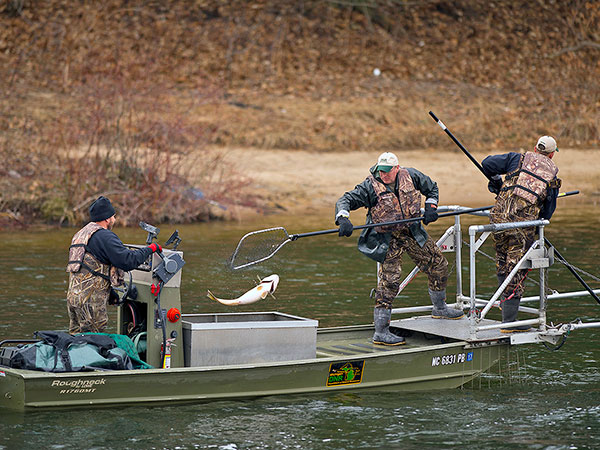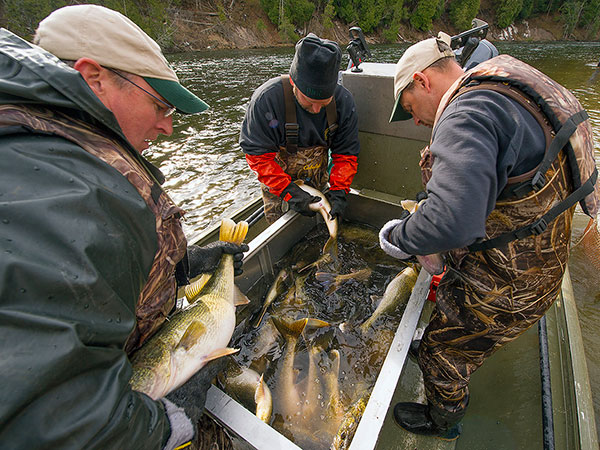(Provided by Michigan DNR)
 Biologists working shock boat capture walleyes for egg taking purposes.As many anglers know, much of Michigan’s inland-waters walleye fishery is supported by hatchery-raised fish. What many don’t know is that the source of those fish - the Muskegon River, below Croton Dam - is supported by hatchery-raised fish, too.
Biologists working shock boat capture walleyes for egg taking purposes.As many anglers know, much of Michigan’s inland-waters walleye fishery is supported by hatchery-raised fish. What many don’t know is that the source of those fish - the Muskegon River, below Croton Dam - is supported by hatchery-raised fish, too.
"There’s not a lot of natural reproduction in the system,” said Rich O’Neal, the Department of Natural Resources fisheries biologist who oversees the Muskegon River watershed. “We’re getting very low production in the river. We’re not sure why, but we think water velocity or water temperature could have something to do with it. We know we get good natural reproduction further upstream.”
“There are 3 to 4 billion eggs laid here when they’re spawning, but we’re just not getting fry production.”
It took a stocking effort to rebuild the Muskegon River population after it collapsed in the 1960s. O’Neal said sea lamprey predation - the preying of one animal on another - on adult walleyes was part of the problem, but alewife predation on juveniles also was a factor. “We saw that all over the Great Lakes,” he said.
O’Neal estimates the population of the Muskegon River spawning run at 40,000 fish, about 18,000 females. Most are migrants.
“There’s about two fish per acre that remain in the river,” he said. “The rest move down to Muskegon Lake or out into Lake Michigan, as far north as Bay de Noc and down to Indiana. It’s been that way since the earliest tagging studies in the 1950s.”
Muskegon River walleyes spawn over a period of three weeks to a month with most of the activity taking place in a 12- to 14-day period, O’Neal said.
“Water temperature is the key,” he said. “They start at 37 to 38 degrees, by 40 they’re really starting to move, and around 45 degrees is peak spawning.” It took a three-man electro-fishing crew, led by Ed Pearce, the fisheries technician supervisor out of the DNR’s Plainwell office, a total of five trips to the river to capture the necessary brood stock. The first attempt, in late March, turned up too many fish that weren’t ready to go. But by the end of the month, the fish had ripened and the crew spent four days spread over a period of about a week to collect the eggs.
It was challenging, Pearce said.
“Last year the river was at flood level, but this year we’re bumping bottom,” said Pearce, who led the crew in a 17-and-a-half-foot johnboat with a 115-horsepower jet drive outboard that can run in mere inches of water. “We couldn’t fill the live well with water, so we couldn’t haul as many fish as we’d like.”
The crew runs a generator that creates direct current sent between the booms on the front of the boat, stunning the fish, which are netted by DNR fisheries personnel standing on the bow.
“It makes the fish twitch,” Pearce said. “It draws them to it. We can shock down to about 6 feet within a 10-foot radius of the booms.”
How the fish react varies, Pearce said.
“Some will be completely knocked out for 10 minutes. Others are just tickled and they take off.”
When a tub of fish is collected, the boat crew brings them to the bank, where a five-person crew from the Wolf Lake State Fish Hatchery takes over.
Fisheries biologist Matt Hughes leads the operation. The fish are divided by sex, and then paired off for spawning.
 DNR teams strip walleyes of eggs and milt.Two workers strip the females’ eggs into pans by pushing on the fish’s bellies, while another massages the male to get it to release milt. The milt is collected in a bottle of water, is circulated, and is dumped into the pan of eggs. Fertilization is almost instantaneous.
DNR teams strip walleyes of eggs and milt.Two workers strip the females’ eggs into pans by pushing on the fish’s bellies, while another massages the male to get it to release milt. The milt is collected in a bottle of water, is circulated, and is dumped into the pan of eggs. Fertilization is almost instantaneous.
Males and females are matched one-to-one in order to promote maximum genetic diversity, Hughes said.
After the eggs are fertilized, they’re transferred into a 5-gallon bucket - along with other fertilized eggs -- that is filled with river water and a fine clay particulate to keep the naturally adhesive eggs from clumping together. Every five pans, the bucket is dumped into a fine-mesh holding pen in the river to allow the eggs to harden. After 60 to 90 minutes, the eggs are put into the transport trailer - which is filled with water from the hatchery - and they’re disinfected with iodine to make sure contaminants aren’t introduced into the hatchery.
“The goal this year was 50 million eggs,” Hughes said. ìWe go through about 250 pairs of walleyes to collect them. We go until we get our target. We can usually get them in four days, but you don’t want all the fish coming at the same time. We don’t have enough room in the hatchery to take them all at once. We can only hold around 10 million fry at one time.”
Some of the fertilized eggs are sent directly to the Platte River State Fishery, where they’ll be hatched out and sent to northern Michigan rearing ponds. Others go to a tribal facility. The rest go to Wolf Lake, where they’ll be hatched and reared. Some will be directly stocked into bodies of water while the majority will go to rearing ponds where they’ll grow to fingerling size before they’re stocked.
“We typically get around 70-80 percent fertilization,” Hughes said. “Our goal is to produce 12 million fry for rearing ponds and direct plants. Eggs take 17 to 21 days to hatch. Fry are held one to five days. We start putting fry out to ponds by the third week of April, and we’re finished by the second week of May.”
The fish are stocked in lakes and streams in the southern two-thirds of Michigan. (Walleyes for northern Michigan stocking projects come from similar egg-takes at Little Bay de Noc.) Among the waters stocked is the Muskegon River, where, after a few years, those walleyes will be collected to serve as brood stock for that year’s egg-take.





